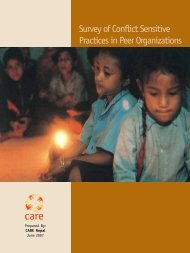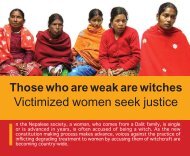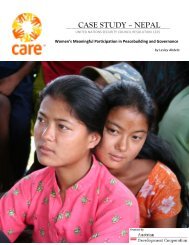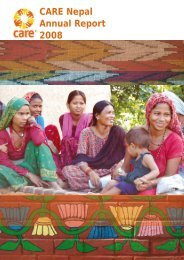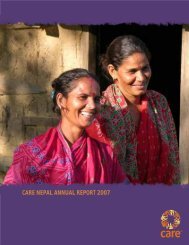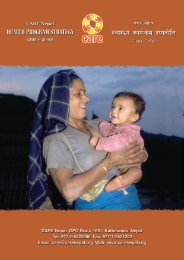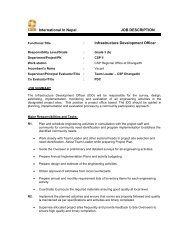Untitled - Care Nepal
Untitled - Care Nepal
Untitled - Care Nepal
Create successful ePaper yourself
Turn your PDF publications into a flip-book with our unique Google optimized e-Paper software.
Background<br />
<strong>Nepal</strong>, a South Asian land-locked<br />
country has a population of 28.6<br />
million. The population growth<br />
rate is just over of 2 percent (CBS, 2003).<br />
The female population is about half of the<br />
total population of <strong>Nepal</strong> (Census 2001)<br />
The literacy rate of <strong>Nepal</strong>ese increased from<br />
39.6 percent in the 1991 census to 53.74<br />
percent in 2001. Hinduism is the major<br />
religion, followed by Buddhism, Islam and<br />
other religions. Amongst Hindus;<br />
Brahmins, Chettris and Dalits are the major<br />
caste groups and there are a multitude of<br />
ethnic groups, often referred to as ‘Janajatis’.<br />
Although women are equal to males in<br />
number in <strong>Nepal</strong>, in social and economic<br />
terms this is certainly not the case. Gender<br />
discrimination against women is a profound<br />
factor that increases vulnerability to a range<br />
of psychosocial and mental health problems.<br />
The Gender Development Index and<br />
Gender Empowerment Index are 0.452 and<br />
0.391 respectively, both at the low end<br />
globally. This reflects the difference<br />
between women and men in burden of labor.<br />
Less than half of adult women (48.9 percent)<br />
receive compensation for their labor<br />
whereas 67.6 percent of men are involved<br />
in compensation-related activities (CBS/<br />
HMG, 2004).<br />
Gender discrimination can be observed at<br />
all socioeconomic levels and across all<br />
ethnic and religious groups. However,<br />
gender discrimination is most profound<br />
among conservative hindu groups and may<br />
be less severe in other ethnic groups.<br />
Women describe greater mental health<br />
problems compared to men in numerous<br />
studies conducted in <strong>Nepal</strong> (Kohrt et al.,<br />
2005b; Tausig et al., 2004; Thapa & Hauff,<br />
2005).<br />
In terms of accessibility, women have much<br />
lower ownership of property. According<br />
to the 2001 Census, only 5 percent women<br />
have ownership of a house, 11 percent of<br />
land and 7 percent of livestock. Ownership<br />
of house and land are higher amongst the<br />
women of urban areas and ownership in<br />
livestock is higher of women in rural areas<br />
(2001 census)<br />
Due to discrimination, lower access to the<br />
services and family restrictions women are<br />
likely to have more psychosocial problems.<br />
It has been found that women who are the<br />
victims of violence are more likely to suffer<br />
from different psychological difficulties<br />
such as depression, anxiety, and post<br />
traumatic stress disorder. Similarly, women<br />
who are victims of discrimination, injustice<br />
are likely to have the problems of<br />
personality disorder, substance abuse, sexual<br />
dysfunction and low self esteem. Violence<br />
against women can have negative effects for<br />
families, communities and economy (DE<br />
Stewart - World Psychiatry, 2006).<br />
6<br />
Psychosocial Issues of<br />
Women affected by conflict



